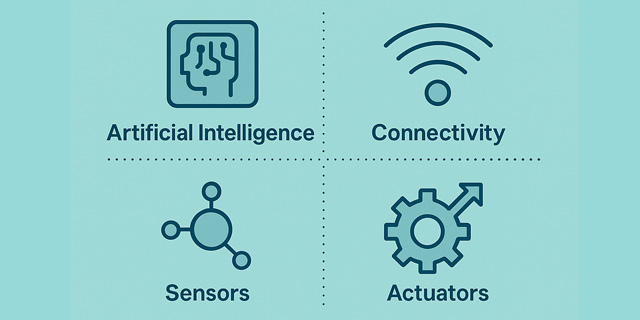Ever wondered what makes a smart device truly “smart”? Behind every AIoT system is a set of key components that work together — from tiny sensors to powerful AI software.
In this article, we’ll break down the main components of AIoT so you can understand what’s happening inside devices like smart speakers, fitness trackers, or factory robots.
1. Why Are Components Important?
Each AIoT device is a system made up of hardware, software, and networking elements. Together, they allow the device to:
- Collect data
- Process information
- Make decisions
- Take action
Let’s explore each of these parts in detail.
2. Hardware Components in AIoT
2.1. Sensors
Sensors are the starting point of any AIoT device. They detect physical conditions and turn them into digital signals.
Common examples:
- Temperature sensors (smart thermostats)
- Motion detectors (security systems)
- Cameras (facial recognition)
- Heart rate sensors (wearables)
- Gas or air quality sensors (air purifiers)
2.2. Microcontrollers and Edge Devices
These are the brains that control the hardware and sometimes even run the AI algorithms locally.
Examples:
- Microcontrollers like Arduino or ESP32 — low-power, ideal for simple logic.
- Edge devices like Raspberry Pi or NVIDIA Jetson — more powerful, can run Edge AI models.
2.3. Actuators
Once a decision is made, actuators perform physical actions:
- Turning on a motor
- Locking a door
- Adjusting fan speed
- Moving a robotic arm
3. Software Components in AIoT
3.1. AI Models
The AI part of AIoT lives in the software. These models analyze data, detect patterns, and make decisions.
Types of AI tasks:
- Classification (Is this a person or an object?)
- Prediction (Will this machine fail soon?)
- Detection (Is there movement in the room?)
- AI models can be trained in the cloud and later deployed to run on the edge.
3.2. Operating Systems & Frameworks
- Embedded OS like FreeRTOS for microcontrollers.
- Linux or Ubuntu for more powerful edge devices.
- Frameworks like TensorFlow Lite, Edge Impulse, or OpenCV power the AI functions.
4. Connectivity Components
4.1. Communication Protocols
To share data, AIoT devices use various wireless technologies:
- Wi-Fi – Home devices and appliances
- Bluetooth – Wearables, short range
- Zigbee/Z-Wave – Smart home networks
- Cellular (4G/5G) – Smart cities, cars
- LoRaWAN – Long-range, low-power networks (used in agriculture, remote monitoring)
4.2. Cloud Services
When devices can’t process data locally, they send it to the cloud for:
- AI training and retraining
- Long-term data storage
- Centralized control
Popular AIoT platforms include:
- AWS IoT
- Microsoft Azure IoT
- Google Cloud IoT
5. Power Supply
All smart devices need power — and it can be a challenge.
- Batteries for portability (wearables, trackers)
- Wired power for more processing power (home hubs, industrial machines)
- Energy harvesting (solar, thermal) in remote AIoT devices
6. Bringing It All Together
Here’s how a complete AIoT system looks:
- Sensors collect data (e.g. motion, temperature).
- Microcontroller processes initial logic.
- Data is analyzed by an AI model (locally or in the cloud).
- A decision is made.
- Actuators take action (turn on a fan, lock a door).
- Data is sent to the cloud for monitoring or learning.
7. Conclusion
Every smart device you use — from your fitness band to your smart doorbell — is powered by a network of components working together.
By understanding these AIoT components, you’ll see how real intelligence is built into everyday objects.


